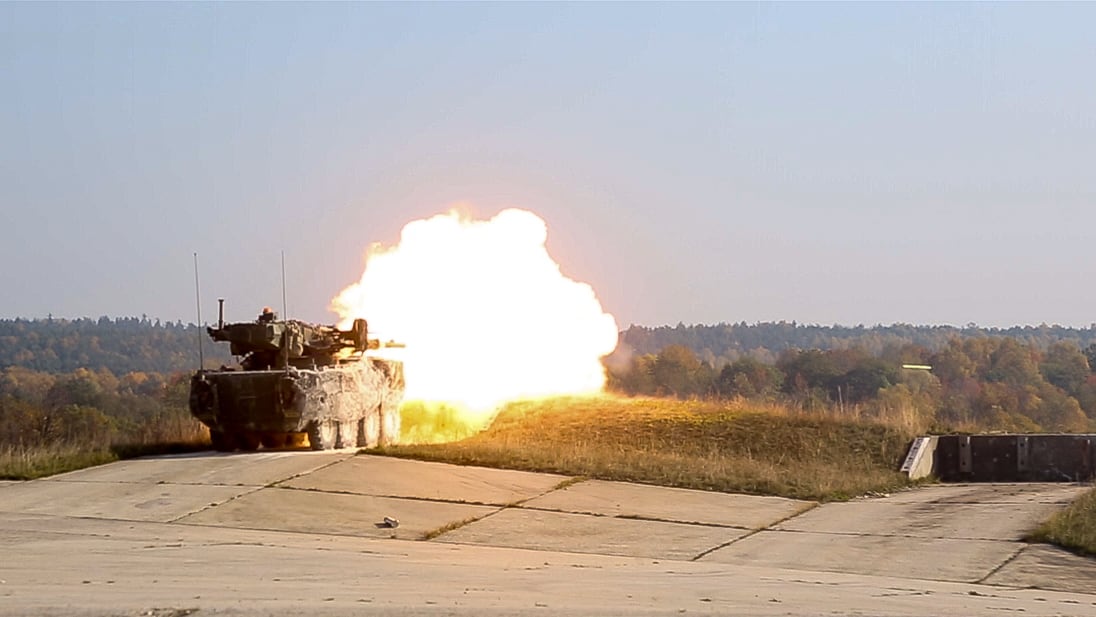UPDATE — This story has been updated to add that Australia is set to receive the Mauser Mk30-2 cannon for its Boxer vehicles and uses the Spike anti-tank guided missile LR2 variant.
RUKLA, Lithuania — Lithuania received its first round of a unique variant of the Boxer infantry fighting vehicle last month— equipped with Israeli-made anti-tank guided missiles and an American-made 30mm cannon — making it the most powerful version of the German-manufactured vehicle.
The Rheinmetall-produced Boxer’s other customers are Australia and Germany, but neither are equipped with a cannon as powerful as a 30mm. Yet, Australia is slated to receive the Mauser Mk30-2 cannon.
And equipping Boxer with a 30mm gun means it shares commonality with the U.S. Army’s upgunned Stryker Infantry Combat Vehicle Dragoon fielded to the 2nd Cavalry Regiment in Germany.
The U.S. recently added more firepower capability to some Strykers due to an urgent operational need in theater as preparation for a possible Russian threat. The service chose the ATK-manufactured Mk44 Bushmaster cannon to do the job.
And the U.S. Army has plans to upgrade at least three Stryker brigades with a 30mm gun in the near term.
RELATED

The Boxer will also carry the Spike non-line-of-sight anti-tank guided missile. The Australian Army’s Boxers are equipped with the LR2 variant.
As Lithuania has no tanks, the Boxer packs the most punch when it comes to firepower within the armed forces and helps the country meet its goal to fully mechanize its Iron Wolf Brigade.
The Iron Wolf Brigade is a mechanized brigade and one of two brigades in the Lithuanian military. It is held at the highest level of readiness. The newer Griffin Brigade — a motorized infantry brigade — was established in 2016 and is based in the western seaport of Klaipeda.
The Iron Wolf Brigade also commands the German-led NATO Enhanced Forward Presence Battalion stationed at Rukla Training Center.
Lithuania, in a tenuous position sharing a border with Belarus and Russian exclave Kaliningrad, has dramatically ramped up its military capability since Russia annexed Crimea from Ukraine in 2014.
Lithuania is joined to Poland by just a short 40-mile border — the Suwalki Corridor — that separates Belarus from Kaliningrad. Should Russian forces close the gap, it would isolate Lithuania and its northern Baltic state neighbors, Latvia and Estonia, from the rest of Europe.
Part of its buildup and modernization efforts include the purchase of Boxers to replace its aging fleet of M113s. Lithuania decided to purchase the vehicles in 2016. There are a total of four M113 battalions in the armed forces.
The first two Boxers were to be delivered to the Iron Wolf Brigade by the end of June, the Lithuanian Ministry of Defence told Defense News during an Atlantic Council-sponsored fact-finding mission there.
The plan is to equip two mechanized infantry battalions within the brigade with 88 new vehicles. Fielding will wrap up in October 2021.
Training on the vehicles started for different groups of specialists and instructors more than a year ago, and further training and preparations to take on the 88 vehicles will continue until the end of 2020, the MoD told Defense News.
It is foreseen the Iron Wolf exercises at the end of 2020 and other national drills will be used for testing and evaluation of the vehicles’ integration into the force, the MoD said.
The Boxers will allow the Lithuanian Armed Forces “to conduct more sophisticated operations as well as significantly increase maneuver and firepower capabilities,” according to a whitepaper issued by the MoD.
The acquisition is the largest investment in military equipment for the Lithuanian Armed Forces since the restoration of its independence in 1990.
Lithuania is considering purchasing other infantry fighting vehicles, but has not laid out requirements such as whether the vehicles would be tracked like M113s or wheeled like its Boxer fleet, according to MoD officials in charge of acquisition and requirements.
It is the country’s goal to mechanize the other two battalions in the Iron Wolf Brigade from 2024 through 2029.
The issue will be addressed after Boxers are integrated into the armed forces and the brigade can take lessons learned from that experience to come up with a procurement strategy for the next round of infantry fighting vehicles in the 2021 time frame.
Jen Judson is an award-winning journalist covering land warfare for Defense News. She has also worked for Politico and Inside Defense. She holds a Master of Science degree in journalism from Boston University and a Bachelor of Arts degree from Kenyon College.







